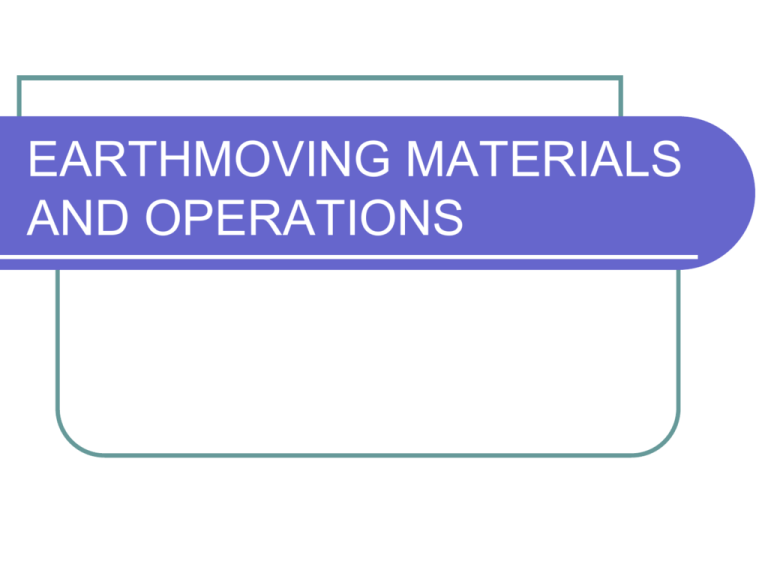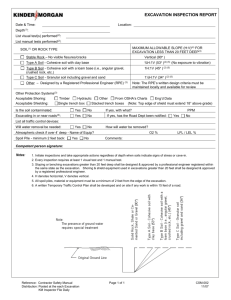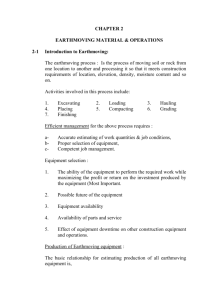EARTHMOVING MATERIALS AND OPERATIONS
advertisement

EARTHMOVING MATERIALS AND OPERATIONS Introduction to Earthmoving Earthmoving is the process of moving soil or rock from one location to another and processing it so that it meets construction requirements such as location, elevation, density, moisture content etc. Activities of earthmoving: Excavation, loading, hauling, damping, spreading, compacting, grading and finishing. Equipment Selection The major criterion in selecting an equipment is the ability of equipment to do the job. This can be specified as: ability to maximise the profit possible future use availability of equipment, spare parts and services the effects of equipment down-time on other construction equipments Production of Earthmoving Equipments Production= Volume per cycle x Cycles per hour Equipment cost per hour Cost per unit of production = Equipment production per hour Production In calculating the job efficiency for cycles per hour there are two methods: Using the number of effective working minutes in an hour to calculate the cycles per hour. To multiply the theoretical number of cycles per 60 min (hour) by a numerical efficiency factor. The following Table shows job efficiency factors for earthmoving operations. Job efficiency factors for earthmoving operations Management Conditions* Job Conditions** Excellent Good Fair Poor Excellent 0.84 0.81 0.76 0.70 Good 0.78 0.75 0.71 0.65 Fair 0.72 0.69 0.65 0.60 Poor 0.63 0.61 0.57 0.52 Management conditions include Skill, training, and motivation of workers; Selection, operation, and maintenance of equipment; Planning, job layout, supervision, and coordination of work. Job conditions Job conditions are the physical conditions of a job that they affect production rate (not including the type of material involved). They include: Topography and work dimensions. Surface and weather conditions. Specification requirements for work methods or Sequence General Soil Characteristics Trafficability : The ability of a soil to support the weight of vehicles under repeated traffic. Trafficability is measured qualitatively. It is function of soil type and moisture. Loadability : is the measure of the difficulty in excavating and loading a soil. Loose granular soils are highly loadable, whereas compacted coehesive soils and rocks have low loadability. General Soil Characteristics Unit weight : Soil unit weight is explained as kilogram per cubic meters. Unit weight depends on type of soil, moisture content and degree of compaction. Moisture Content: In their natural state, all soils contain some moisture. The moisture content is expressed as percentage. Moist weight - Dry weight Moisture content (%) = 100 Dry weight Soil Volume Change Characteristics Soil Conditions There are three conditions that the soil may exist: Bank (in place or in situ): Material in its natural state before disturbance (Bm3). Loose : Material that has been excavated or loaded (Lm3). Compacted : Material state after compaction (Cm3). Swell Soil volume increases after excavation since the soil grains are loosened during excavation and air fills the void spaces created. As a result one unit volume of soil in the bank condition will occupy more than one unit volume after excavation. This is called as Swell. Swell can be calculated as: Weight/bank volume Swell (%) ( 1) 100 Weight/loose volume Example Problem : Find the swell of a soil that weighs 2800kg/m3 in its natural state and 2000kg/m3 after excavation. Solution : Swell ( 2800 1) 100 = 40% 2000 This means that 1 bank m3 of material will expand to 1.4 m3 loose volume after excavation. Shrinkage When a soil is compacted, some of the air inside of the soil is forced out. As a result the soil occupies less volume than it does either in bank or loose conditions. This is the reverse of swell and called as shrinkage. Weight/bank volume Shrinkage (%) = (1 ) 100 Weight/Compacted volume Load and Shrinkage Factors In earthmoving contracts, it is important to convert all material volumes to a common unit of measure. Haul unit or spoil bank volumes are commonly expressed in loose measure. Conversion factor to convert from loose to bank volume is called as Load Factor. Loose volume is multiplied by load factor to find bank volume. Load and Shrinkage Factors Load factor = Weight / loose unit volume Weight / bank unit volume 1 Load Factor = 1 + Swell To convert a volume from bank volume to compacted volume, shrinkage factor is used. Shrinkage Factor Weight/ bank unit volum e Weight/compacted unit volum e Shrinkage Factor 1 Shrinkage Example Problem: A Soil Weighs 1163kg/Lm3, 1661kg/Bm3 and 2077kg/Cm3, a) Find load factor and shrinkage factor. b) How many bank Bm3 and compacted Cm3 are contained in 593,300 Lm3 of this soil. Solution a) Load Factor = 1163 = 0.70 1661 1661 Shrinkage Factor = = 080 . 2077 b) Bank Volume = 593,300 0.70 = 415,310 Bm3 Compacted Volume = 415,310 0.8 = 332,248Cm 3 Example A soil weighs 1471 kg/m3 loose, 1839 kg/m3 in place and 2090 kg/m3 compacted. Find the swell and shrinkage. Find load factor and shrinkage factor. If an earth fill dam requires a compacted volume of 4.6*106 m3 of the above soil. How many loose cubic meter of this soil must be hauled to construct the dam. Solution a- Swell (%) ( Weight/bank volume 1) 100 Weight/loose volume 1839 Swell (%) ( 1) 100 25% 1471 Shrinkage (%) = (1 - Weight/bank volume ) 100 Weight/Compacted volume Shrinkage (%) = (1- 1839 ) 100 12% 2090 Solution Load Factor = Load Factor = 1 1 + Swell 1 0.80 1 + 0.25 Shrinkage Factor 1 Shrinkage Shrinkage Factor 1 0.12 0.88 Solution Compacted volume = (bank volume x shrinkage factor) Bank Volume = Compacted _ Volume 4.6 *106 5227272Bm 3 Shrinkage_ factor 0.88 BankVolume 5227272 Losse _ Volume 6534091Lm 3 LoadFactor 0.80 Spoil Banks In earthwork planning it may be necessary to determine the size of the pile of soil that will be created by excavation. If the pile of material is long in relation to its width, it is referred to as spoil bank. If the material is dumped from a fixed position, a soil pile is created which has a conical shape. To determine the dimensions of spoil banks or piles, it is first necessary to convert the volume of excavation from in-place to loose conditions. Angle of repose of soil is the angle that the sides of a spoil bank or pile naturally form with the horizontal surface when the excavated soil is dumped onto the pile. Triangular Spoil Bank Volume Section area length 4V B=( )1/2 L tanR B tanR H= 2 Where: B: base width (m) H: pile height (m) L: pile length (m) R: angle of repose (deg) V: pile volume (m3) Conical Spoil Pile 1 Volume = Base area height 3 7.64V 1/ 3 D=( ) tan R D H = tan R 2 Where D is the diameter of the pile (m). Table 2.6 (p. 31) shows typical values of angle of repose of soils. Typical Values of Angle of Repose of Excavated Soils Material Angle of Repose (degrees) Clay 35 Common earth, dry 32 Common earth, moist 37 Gravel 35 Sand, dry 25 Sand, moist 37 Example Problem: Find the base width and height of a triangular spoil bank containing 76.5 Bm3 if the pile is 9.14m, the soil’s angle of repose is 37°, and its swell is 25 %. Solution Loose volume=76.5 x 1.25=95.6m3 4V B=( )1/2 L tanR B tanR H= 2 4 95.6 1/2 Base width = ( ) = 7.45m 9.14 tan 37 7.45 Height = tan 37 = 2.80m 2 Example Problem: Find the base diameter and height of a conical spoil pile that will contain 76.5 Bm3 of excavation if the soils angle of repose is 32° and its swell is 12%. Solution Loose volume=76.5 x 1.12=87.5m3 7.64V 1/ 3 D=( ) tan R D H = tan R 2 7.64 85.7 1 / 3 Base diameter = ( ) 10.16m tan 32 Height = 10.16 tan 32 3.17m 2 Example A rectangular ditch having a cross-sectional area of 2.4 m2 is being excavated in a clay. The soil’s angle of repose is 35o and its swell is 30%. Find the height and base width of the triangular spoil bank that will result from the trench excavation. Solution B( 4V 1/ 2 4 section _ area L 1/ 2 4 section _ area 1/ 2 ) ( ) ( ) L tan R L tan R tan R Considering section area as loose measure = 2.4 x 1.3 = 3.12 m2 4 3.12 B tan 35 1/ 2 H 4.22m B(tan R) 4.22(tan 35) 1.478m 2 2 Soil Identification and classification Fundamental Soil Types Soil is considered to be composed of five fundamental soil types: gravel, sand, silt, clay, and organic material. Gravel: is composed of individual particles larger than 6 mm but smaller than 76 mm. Sand: material smaller than gravel but larger than 0.07 mm (No. 200 sieve). Silt: particles passing No. 200 sieve but larger than 0.002 mm. Clay: is composed of particles less than 0.002 mm in diameter. Organic soils: contain partially decomposed vegetable matters. Soil Classification Systems Liquid Limit (LL) of a soil is the water content (expressed in percentage of dry weight) at which the soil will just start to flow when subjected to a standard shaking test. Plastic limit (PL) of a soil is the moisture content in percent at which the soil just begins to crumble when rolled into a thread 0.3 cm in diameter. Plasticity index (PI) is the numerical difference between the liquid and plastic limits and represents the range in moisture content over which the soil remains plastic.







